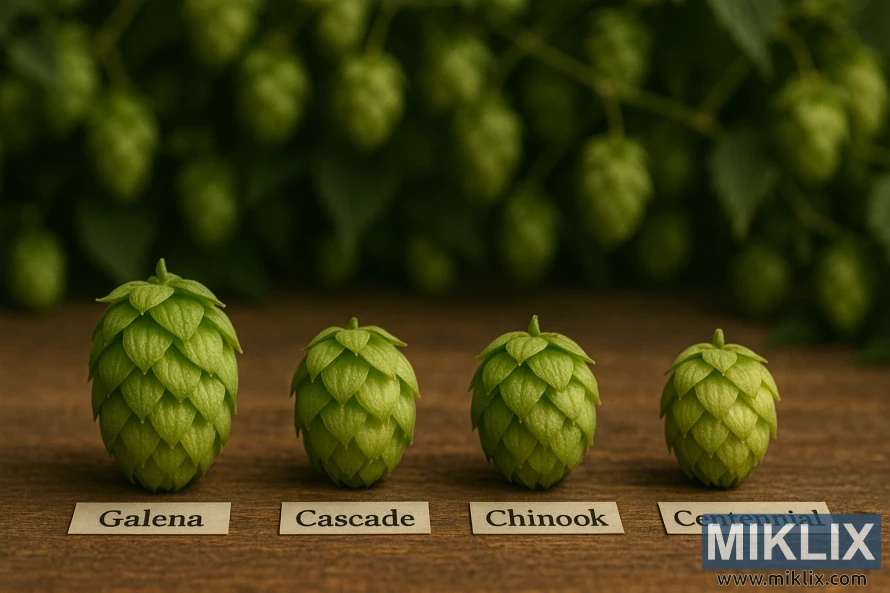Image: Comparison of Hop Varieties
Published: July 26, 2025 at 7:24:58 AM UTC
Last updated: September 27, 2025 at 12:11:36 PM UTC
Rustic table displaying Galena, Cascade, Chinook, and Centennial hops, highlighting their unique colors, textures, and brewing qualities.
Laid carefully across a rustic wooden surface, four hop cones stand like jewels of the brewing world, each one distinct in size, shape, and subtle texture. The warm glow of natural light filters gently across the scene, highlighting their delicate bracts and the vibrant shades of green that differentiate one from the other. At the forefront sits the Galena cone, the largest of the four, its elongated structure and tightly layered leaves exuding a sense of density and power. To its right lies Cascade, more compact, with a slightly rounder form that seems to hint at the bright citrus and floral character for which it is so beloved. Next is Chinook, a little more rugged in appearance, with its bracts arranged in a way that suggests boldness and intensity, echoing the piney and resinous notes that define its personality in beer. Finally, Centennial, the smallest of the four, sits at the far right, neatly balanced and symmetrical, representing the versatility and balance that have made it a cornerstone of countless recipes.
Beneath each cone, a small label bearing its name grounds the composition, transforming this still life into both a visual comparison and an educational tableau. These labels don’t just identify the cones—they serve as an invitation for the viewer to imagine their aromas and flavors, to mentally trace the sensory journey each hop variety takes once it leaves the bine and enters the brew kettle. They represent not just agricultural products, but carefully cultivated cultivars, each with a unique lineage, each developed to bring its own contribution to the ever-expanding tapestry of beer styles.
The blurred backdrop completes the scene, a tangle of hop bines rendered in soft focus. Their leafy tendrils and distant cones create an atmospheric depth, reminding the viewer of the living plants from which these cones were harvested. This lush green curtain gives context to the individual specimens in the foreground, emphasizing the transition from the abundance of the field to the precision of selection. It also conveys a sense of continuity, a cycle that begins with cultivation and ends with the crafting of beer, only to begin again with each year’s harvest.
What is most striking about this arrangement is the way it encapsulates the diversity and complexity of hops within such a simple frame. Each cone, though similar in structure, tells its own story: Galena with its earthy bitterness, Cascade with its citrus sparkle, Chinook with its bold pine and spice, and Centennial with its floral balance. Together, they form a kind of chorus, each voice distinct yet complementary, underscoring the idea that brewing is as much about harmony as it is about individuality.
This image resonates with the curiosity of both brewers and enthusiasts, presenting not just a comparison but an exploration of possibility. It invites the viewer to consider how these varieties might be combined, layered, or showcased, how their chemistry might interact with malt and yeast, and how they might shape the experience of the drinker. The scene, though quiet and still, vibrates with potential, embodying the artistry of brewing and the essential role that hops play in it.
The image is related to: Hops in Beer Brewing: Galena

